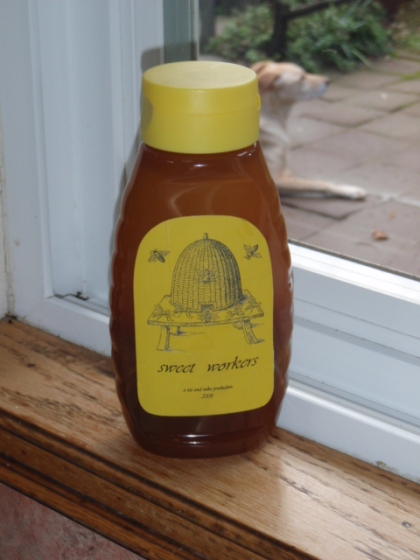Sweet Workers
February 14, 2009

My friends Mike and Tai are making their own honey: Sweet Workers. It is sweet, and it’s as local as you can get: they make it in Mike’s San Francisco backyard.
I love these guys. Lived next door to Mike as a student in Florence, Italy. We were all there as part of the California State University’s International Program, studying architecture (Mike and Tai), Italian Renaissance Art and Literature (Julie), and food (Mike, Tai and Julie.) Tai lived a few blocks away, but was over at our apartment often to cook, drink cheap Chianti, and speak Italian. But I digress …
I love that Mike and Tai are still keeping it real in the kitchen. They do things from scratch. A couple of years ago we had a Boxing Day party at our place and Tai showed up with the makings for Pear Flambe.

Making Pear Flambe on Boxing Day
Sweet Workers honey comes from the natural habitat Mike and Tai have created in their urban environment of San Francisco. Don’t let anyone tell you you can’t farm in the city.
” Honeybees use nectar to make honey. Nectar is almost 80% water with some complex sugars. In fact, if you have ever pulled a honeysuckle blossom out of its stem, nectar is the clear liquid that drops from the end of the blossom. In North America, bees get nectar from flowers like clovers, dandelions, berry bushes and fruit tree blossoms. They use their long, tubelike tongues like straws to suck the nectar out of the flowers and they store it in their “honey stomachs”. Bees actually have two stomachs, their honey stomach which they use like a nectar backpack and their regular stomach. The honey stomach holds almost 70 mg of nectar and when full, it weighs almost as much as the bee does. Honeybees must visit between 100 and 1500 flowers in order to fill their honeystomachs.
The honeybees return to the hive and pass the nectar onto other worker bees. These bees suck the nectar from the honeybee’s stomach through their mouths. These “house bees” “chew” the nectar for about half an hour. During this time, enzymes are breaking the complex sugars in the nectar into simple sugars so that it is both more digestible for the bees and less likely to be attacked by bacteria while it is stored within the hive. The bees then spread the nectar throughout the honeycombs where water evaporates from it, making it a thicker syrup. The bees make the nectar dry even faster by fanning it with their wings. Once the honey is gooey enough, the bees seal off the cell of the honeycomb with a plug of wax. The honey is stored until it is eaten. In one year, a colony of bees eats between 120 and 200 pounds of honey.” – From the Lansing State Journal, July 30, 1997
Tastes sweet and thick. I’ve been using it in my coffee and melting it with warm butter on toast in the morning. Thanks Mike and Tai … you are sweet workers!